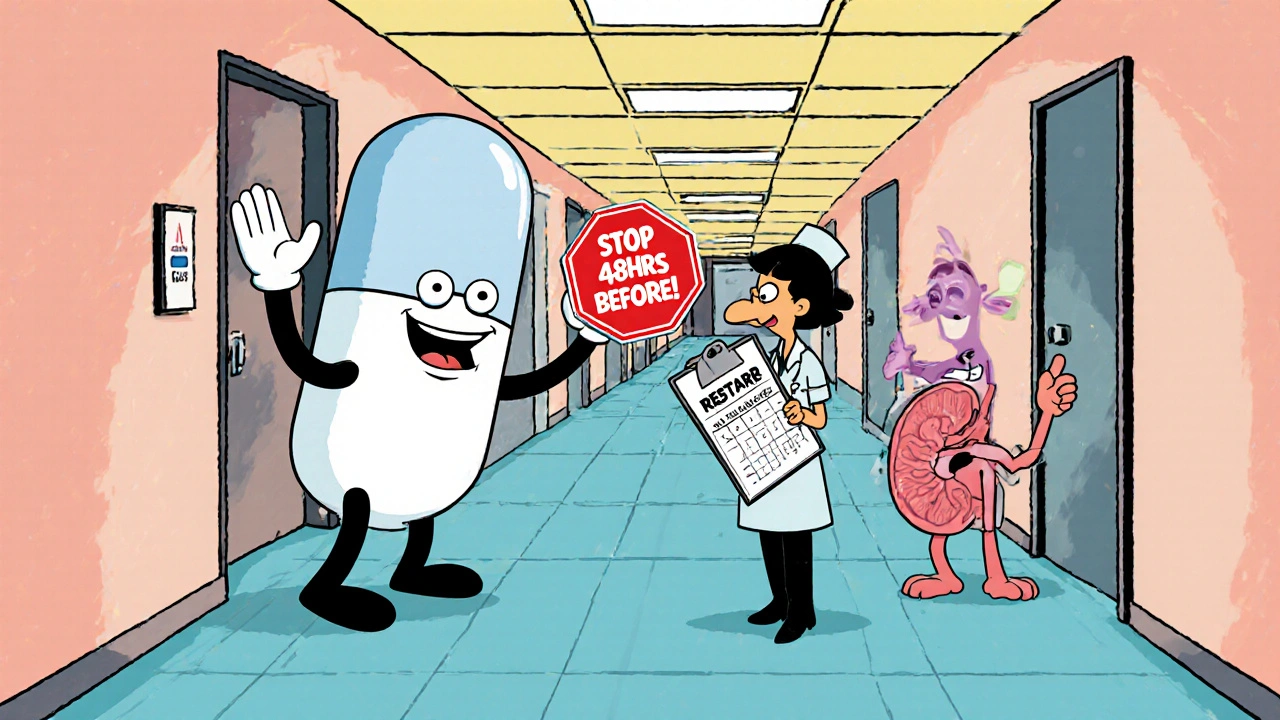Metformin Lactic Acidosis Risk Calculator
This tool calculates your risk of lactic acidosis while taking metformin based on specific medical factors. According to FDA data, lactic acidosis is extremely rare in healthy patients (1-9 cases per 100,000 patients annually), but risk increases with certain conditions. This calculator provides personalized insight based on the latest medical evidence.
Personal Risk Factors
Your Risk Assessment
What This Means
According to FDA data from 2022, among 15.2 million metformin users, there were only 12 confirmed cases of lactic acidosis. The risk is extremely low for healthy patients taking metformin as prescribed. However, certain medical conditions significantly increase the risk.
The most important risk factors are kidney function (eGFR below 30 mL/min/1.73m²), acute kidney injury (24x increased risk), severe liver disease (8x increased risk), and heavy alcohol consumption (7x increased risk).
Metformin is the most commonly prescribed diabetes medication in the world. Over 150 million prescriptions are filled each year in the U.S. alone. It works well, helps with weight, and lowers blood sugar without causing dangerous lows. But for many people, starting metformin feels like trading one problem for another. Stomach cramps, diarrhea, nausea - these aren’t just minor annoyances. They’re real, frequent, and often enough to make people quit the drug. And then there’s the scary word: lactic acidosis. It sounds deadly. And it can be. But how likely is it really? And what should you actually watch for?
Why Your Stomach Hurts After Starting Metformin
Up to 30% of people who start metformin get gastrointestinal side effects. That’s not rare - it’s the norm. The most common symptoms? Diarrhea (affects over half of those who have issues), nausea, stomach pain, vomiting, and loss of appetite. These don’t show up months later. They hit hard in the first few weeks. About two-thirds of people feel something within the first 30 days.
Here’s the good news: for 85% of people, these symptoms fade on their own within two to four weeks. Your body adjusts. But waiting that long without help isn’t easy. If you’re skipping meals because you feel sick, or avoiding social events because you’re stuck near a bathroom, you need solutions - not just reassurance.
The key is how you start. Taking a regular metformin tablet with food helps, but not enough for many. Extended-release (ER) versions are designed to release the drug slowly, so less hits your gut at once. Studies show switching to metformin ER cuts GI side effects by nearly half. One patient on Reddit, who had been having five diarrhea episodes a day, dropped to occasional mild cramps after switching to 500mg ER taken at dinner. That’s not luck - it’s science.
Another trick: start low. Don’t jump to 1,000mg on day one. Begin with 500mg once daily, then add another 500mg after a week if you tolerate it. Many doctors skip this step. But going slow gives your gut time to adapt. If you’re still struggling after four weeks, talk to your doctor about switching formulations or adding a probiotic. Some small studies suggest certain strains, like Lactobacillus acidophilus, can reduce bloating and loose stools.
Lactic Acidosis: The Real Risk - And Why You Shouldn’t Panic
Metformin carries a black box warning from the FDA - the strongest possible - for lactic acidosis. That sounds terrifying. And it should. But let’s put it in perspective.
Between 1959 and 1996, there were 318 reported cases of lactic acidosis linked to metformin, with 62 deaths. That’s over 30 years. Today, with better screening and monitoring, the rate is about 1 to 9 cases per 100,000 patients each year. In 2022, the FDA reviewed data from 15.2 million metformin users and found only 12 confirmed cases. That’s 0.079 per 100,000. You’re far more likely to be struck by lightning than to develop metformin-associated lactic acidosis (MALA) if you’re healthy.
Here’s the truth: MALA almost never happens in people who take metformin as prescribed and have normal kidney and liver function. It’s not the drug itself that’s the problem - it’s what’s happening in your body when you’re already critically ill. About 93% of cases occur in patients with severe kidney disease, liver failure, heart failure, or those who’ve had a recent heart attack or stroke.
Two types of lactic acidosis happen with metformin: incidental and induced. Incidental is the big one - your body is already failing, and metformin makes it worse. Metformin-induced lactic acidosis (from overdose) is extremely rare. Most cases are from people who took too much, or who were already in shock or sepsis.
Who’s at Real Risk - And Who’s Not
Not everyone with diabetes is at equal risk. The biggest red flag? Kidney function. If your eGFR (a measure of kidney filtering) drops below 30 mL/min/1.73m², your risk of lactic acidosis jumps 18.7 times. That’s why doctors check your kidney numbers every 3 to 6 months if your eGFR is between 45 and 59, and monthly if it’s below 45. If it falls below 30, metformin must stop.
Other major risk factors:
- Acute kidney injury - increases risk over 24 times
- Severe liver disease - increases risk 8 times
- Age over 80 - increases risk nearly 5 times
- Drinking 3 or more alcoholic drinks a day - increases risk nearly 7 times
Here’s what doesn’t raise your risk: taking metformin if your kidneys are normal. It doesn’t damage your kidneys. It doesn’t cause dementia. It doesn’t permanently steal your vitamin B12. Yes, long-term use can slightly lower B12 levels - but in 94% of cases, it’s reversible with a simple supplement. Annual blood tests catch this easily.
And here’s a myth that needs killing: metformin doesn’t cause lactic acidosis in healthy people. Experts like Dr. Kenneth Cusi from the University of Florida say the 30-50% death rate you hear about applies only to patients in intensive care with multiple organ failures - not to someone taking 1,500mg a day with normal labs.

What Symptoms Should You Never Ignore?
While lactic acidosis is rare, it’s deadly when it happens. You need to know the signs - and act fast.
Early symptoms often mimic the GI side effects you already know: nausea, vomiting, stomach pain. But if you start feeling:
- Extreme fatigue - not just tired, but like you can’t move
- Rapid, shallow breathing - you feel like you can’t catch your breath
- Muscle pain or weakness - especially if it’s new and severe
- Feeling cold, even in a warm room - hypothermia is a late sign
These aren’t normal. If you have these symptoms - especially if you’ve been sick, dehydrated, or had surgery recently - go to the emergency room. Don’t wait. Don’t call your doctor tomorrow. Go now.
Doctors diagnose lactic acidosis with blood tests: arterial pH below 7.35, lactate levels above 5 mmol/L, and an anion gap over 12. These numbers don’t lie. If you’re on metformin and your labs show this, you need immediate treatment - fluids, oxygen, sometimes dialysis.
What to Do Before Procedures Involving Contrast Dye
If you’re scheduled for a CT scan, angiogram, or any procedure using iodine-based contrast dye, you must stop metformin. Why? The dye can temporarily impair kidney function. If your kidneys slow down while you’re still taking metformin, the drug builds up - and that’s when lactic acidosis risk spikes.
The rule is simple: stop metformin 48 hours before the procedure. Don’t restart it until 48 hours after, and only if your kidney function is checked and normal. Many patients forget this. Some even take their pill the morning of the scan. That’s dangerous. Always confirm with your doctor or radiology team. Write it down. Set a phone reminder.

What’s New in Metformin - And What’s Still the Same
In May 2023, the FDA approved a new extended-release formula called Metformin-ER-XR. In clinical trials, it reduced gastrointestinal side effects by over 40% compared to older versions. That’s a big deal for people who’ve struggled to stay on the drug.
But the core advice hasn’t changed. Metformin is still the safest, most effective first-line treatment for type 2 diabetes. The benefits - lower blood sugar, less weight gain, lower heart disease risk - far outweigh the risks for the vast majority of people.
Don’t let fear stop you. But don’t ignore warning signs. If your stomach hurts, talk to your doctor about switching to ER. If you’re over 70, or have heart or kidney issues, make sure your labs are checked regularly. If you feel suddenly exhausted or short of breath, don’t think it’s just the flu. Get checked.
Metformin isn’t perfect. But it’s still the best tool we have. And when used correctly, it saves lives - not just from high blood sugar, but from heart attacks, strokes, and kidney failure. The side effects are manageable. The serious risks are preventable. You just need to know the signs, know your numbers, and speak up.
Can metformin cause permanent kidney damage?
No, metformin does not cause kidney damage. Studies tracking patients for over 10 years show no increased risk of kidney decline in people taking metformin compared to those who don’t. In fact, poor kidney function is the reason doctors stop metformin - not because the drug harms the kidneys, but because damaged kidneys can’t clear it properly, raising the risk of lactic acidosis. Regular monitoring of eGFR is essential, but metformin itself is not the cause of kidney problems.
Is lactic acidosis common with metformin?
No, it’s extremely rare. Between 1 and 9 cases occur per 100,000 patients each year. In 2022, the FDA found only 12 confirmed cases among 15.2 million metformin users. Most cases happen in people who are already critically ill - with severe kidney failure, liver disease, heart attack, or sepsis. Healthy patients taking metformin as prescribed have almost no risk.
How can I reduce stomach side effects from metformin?
Switch to the extended-release (ER) version, which releases the drug slowly and reduces gut irritation. Start with a low dose (500mg once daily) and increase slowly over weeks. Take it with food, not on an empty stomach. Many patients find taking it at dinner helps. If symptoms persist after 4 weeks, talk to your doctor about probiotics or alternative formulations.
Should I stop metformin if I get sick?
Yes - if you’re severely ill with vomiting, diarrhea, fever, or dehydration, stop metformin until you recover. Illness can stress your kidneys and raise lactic acid levels. Don’t wait for symptoms to get worse. Contact your doctor. Restart only after you’re eating and drinking normally, and your kidney function is confirmed normal.
Does metformin lower vitamin B12 levels?
Yes, long-term use can reduce B12 levels in about 7% of users. But this is usually mild and reversible. The 2023 AACE guidelines recommend checking B12 every 2-3 years for people on metformin for more than 4 years. If levels are low, a simple oral or injectable supplement restores them in nearly all cases. Don’t assume fatigue or numbness is from diabetes - get your B12 tested.
Can I take metformin if I drink alcohol?
Moderate alcohol (1-2 drinks occasionally) is usually fine. But heavy drinking - 3 or more drinks per day - increases lactic acidosis risk nearly 7 times. Alcohol affects liver function and can cause dehydration, both of which raise your risk. If you drink heavily, talk to your doctor. You may need to stop metformin or switch to another medication.
What should I do before a CT scan with contrast dye?
Stop metformin 48 hours before the scan. Do not restart it until 48 hours after, and only after your doctor confirms your kidney function is normal. Many hospitals have protocols for this - but don’t assume they’ll remind you. Write it down. Set a reminder. Never take metformin the morning of your scan.
What Comes Next?
If you’re on metformin and feeling fine, keep taking it. Keep your kidney tests on schedule. Get your B12 checked every few years. If you’re struggling with stomach issues, ask about the extended-release version. If you’ve been told to stop metformin because of kidney numbers, ask why - and if there’s another option.
Metformin isn’t a magic bullet. But for millions, it’s the difference between managing diabetes and being controlled by it. The risks are real - but they’re not random. They’re predictable. And they’re preventable. You don’t need to fear metformin. You need to understand it. And with that understanding, you can take control - not just of your blood sugar, but of your health.


Comments (8)
Linda Rosie
22 Nov, 2025Metformin ER made all the difference for me. Started at 500mg with dinner, no more midday bathroom emergencies. Just slow and steady.
Vivian C Martinez
23 Nov, 2025So many people panic about lactic acidosis without understanding how rare it is in healthy individuals. The real issue is skipping kidney checks. Stay on top of your eGFR, and metformin is one of the safest tools we have.
Ross Ruprecht
23 Nov, 2025Ugh I tried metformin once and felt like I was dying for two weeks. Guess I’m just not built for it. My doctor said ‘tough it out’ like it was a rite of passage. Nope. Switched to GLP-1. Better vibes.
Bryson Carroll
25 Nov, 2025Everyone’s so scared of lactic acidosis but nobody talks about how the FDA warning exists because of bad data from the 90s when people were taking metformin with alcohol and kidney failure and no monitoring. It’s not the drug it’s the context. Stop blaming the medication and start blaming the lazy prescribing
Jennifer Shannon
26 Nov, 2025You know what’s fascinating? The way we treat metformin like it’s this dangerous beast, when in reality it’s been used for over 60 years, and in that time, it’s saved more lives than most drugs ever will. It doesn’t cause kidney damage - it’s the other way around. It doesn’t cause lactic acidosis - it’s the body’s collapse that does. We’ve turned a simple, effective, cheap, life-extending medication into a villain because we’re terrified of complexity. And yet, we’re told to trust science - but only when it’s convenient. The truth is, metformin doesn’t need fear. It needs understanding. And maybe, just maybe, a little more humility from the people who prescribe it.
Suzan Wanjiru
26 Nov, 2025For the GI stuff just take it with food and go slow. I did 500mg for 10 days then added another 500mg. By week 3 I was fine. Also probiotics helped a lot. I took Culturelle daily. No magic just patience and timing. And yeah ER version is way better if you can afford it.
Kezia Katherine Lewis
27 Nov, 2025The clinical literature consistently demonstrates that metformin-associated lactic acidosis (MALA) is a diagnosis of exclusion - predicated on the presence of severe comorbidities including acute kidney injury (AKI), hepatic decompensation, or septic shock. In the absence of these, the pharmacokinetic profile of metformin remains benign. The black box warning, while legally necessary, is not clinically proportional to the population-level risk. We must distinguish between pharmacological risk and pathophysiological vulnerability.
Manjistha Roy
28 Nov, 2025As someone from India where metformin is the first-line drug for nearly everyone with type 2 diabetes, I’ve seen how it transforms lives. People who couldn’t walk up stairs now walk to the market. But we also see people stop it because of stomach upset - and then their sugar skyrockets. The solution isn’t quitting. It’s education. Start low. Go slow. Talk to your doctor. Your body will thank you.